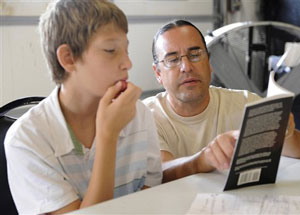
Miami University is revitalizing the language of the Miami Tribe, the university’s namesake. The project is directed by Daryl Baldwin, a member of the Miami Tribe.
Baldwin was born around the time that his Miami Tribe of Oklahoma was losing its last generation of fluent speakers and facing the possibility that its language would die with them.
Fifty years later, a project that Baldwin directs at Miami University in southwest Ohio is making headway reclaiming and revitalizing the Myaamia language, through a collaboration that linguists around the country say is an outstanding role model to help save dormant languages from extinction. The collaborative project between the tribe and its namesake university recently became a full-fledged center on the Oxford campus, a move that the university and linguists say enhances the project's efforts and expands access to grants and other resources.
"In 2001, I started out with just a desk in the library," said Baldwin, founding director of the center that now has full and part-time staff and student assistance.
The center serves as a research and development arm for the tribe, conducting research to help preserve the language, culture, and development of educational materials. It has produced such tools as an online dictionary and mobile apps to help people learn and speak the language. It also exposes students throughout the university to efforts to revitalize the language and culture, providing visits to tribal headquarters, direct involvement in research, and class visits by center staff.
Tribal officials are pleased with the new center, which they say gives more permanency to the effort to preserve their language and culture.
"It assures us that this will go on for a long time," said Julie Olds, cultural resources officer at the tribe's Miami, Okla., headquarters.
The Miami name is derived from the original Myaamia. The Myaamia people inhabited land now within the borders of Ohio - including the region where the university now stands - Illinois, Indiana, and parts of Michigan and Wisconsin, before the government forced relocations to territories that later became Kansas and Oklahoma.
The center grew out of a more than 40-year-old relationship between the university and the tribe, which has about 4,000 members and fewer resources than larger Native American groups working to save their languages. But tribal officials say the university partnership has provided research and development tools that the tribe would not have had otherwise and sparked a new desire- especially among young tribal members -to learn about their language and culture.
While it's difficult to determine how many people are now fluent in the language, "at least it is now being used again," Olds said. She said language, culture camps, and workshops growing out of the partnership also are drawing young people, and even older ones.
"It's all about restoring knowledge to the Myaamia community, and the center is key," Olds said.
Haley Strass, a 22-year-old tribal member from Huntington, Ind., is among 21 students now attending Miami University on scholarships available to qualified tribal members. Her grandmother encouraged her to go there to seek more knowledge about their heritage.
"It's helped me determine who I am within the American culture, and see that I also have a place in the Native American population," Strass said.
She said her father's generation was mostly taught to suppress Native American culture for fear it would prevent acceptance by the wider society, and the director of the Salem, Ore.-based Living Tongues Institute for Endangered Languages, says one of the reasons languages are abandoned is that "speakers believe it could hold them back."
 "That perception isn't true, but it's difficult to fight," said institute director Gregory Anderson.
"That perception isn't true, but it's difficult to fight," said institute director Gregory Anderson.
Nearly half of an estimated 6,000 to 7,000 languages spoken in the world today are in danger of disappearing in this century, according to linguists. But Anderson says the successful collaboration at Miami has been instrumental in fighting against language shifts, where original languages are abandoned in favor of others.
Mary Linn, associate curator of Native American Languages at the Sam Noble Oklahoma Museum of Natural History at the University of Oklahoma, says about 17 of the 39 tribes in Oklahoma are in the same situation as the Miami Tribe. She said the Myaamia Center is an important role model that gives "hope and inspiration" to those tribes.
Baldwin says the center's message is simple.
"We have to get people to understand that we are a living people with a past," he said. "And not a people from the past."
Copyright 2013 The Associated Press.

Comments
I thought this was a
I thought this was a beautiful story, especially the part about this particular tribe being "a people with a past". Not many people consider Native American languages when they think of foreign language studies, but I think it's great that one man cared enough to try and change that. We live in a culturally rich world, and it seems almost tragic that languages are slowly dying out. It might seem easier for everyone to speak English, but I believe that when a people group loses their language, in a way they are losing part of their culture. Perhaps the efforts of this man will inspire similar work on other college campuses to start new foreign language groups. It's even a bit refreshing that one would be able to learn a unique language as opposed to the traditional courses of Spanish and French.